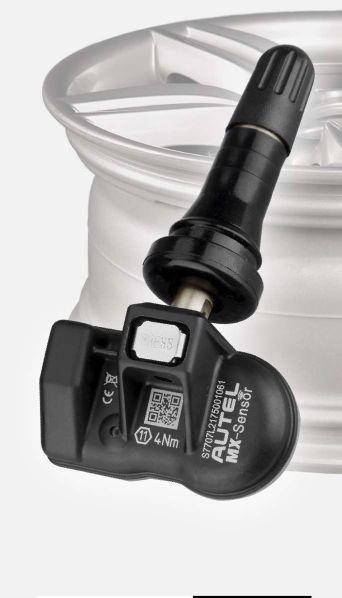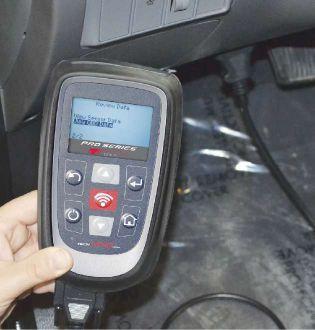
8 minute read
TPMS

from Modern Tire Dealer - December 2018
by EndeavorBusinessMedia-VehicleRepairGroup
Fiat 500 Series 2012-2018
SUBJECT VEHICLES: Fiat 500 Series 2012-2018 RELEARN PROCEDURE? No. SPECIAL TOOLS NEEDED? A RKETPMS analyzer can be used to determine the sensor’s frequency without having to demount the tire.
The tire pressure monitoring system (TPMS) of the 2012-2018 Fiat 500 Series uses wireless technology with wheel rim mounted electronic sensors to monitor tire pressure levels. Sensors, mounted to each wheel as part of the valve stem, transmit tire pressure readings to the receiver module. The TPMS consists of the following components: • Receiver module • Four tire pressure monitoring sensors • Tire pressure monitoring telltale light
There are two tire pressure monitoring systems available, a base system and a premium system. The base system does not specify how many tires are low or where they are located. The premium system does so.
NOTE: The compact spare tire does not have a tire pressure monitoring sensor.
A TPMS fault can occur with any of the following scenarios: • Signal interference due to electronic
devices or driving next to facilities emitting the same radio frequencies as the TPMS sensors. • Installing some form of aftermarket window tinting that affects radio wave signals. • Snow or ice around the wheels or wheel housings. • Using tire chains on the vehicle. • Using wheels/tires not equipped with TPMS sensors.
TIRE PRESSURE MONITOR WARNING INDICATORS The TPMS warning light will illuminate in the instrument cluster, an audible chime will be activated, and the “Check Tire Pressure” text message will display when one or more of the four active road tire pressures are low.
Inflate each tire to the vehicle’s recommended cold placard pressure value. The system will automatically update and the tire pressure monitoring light will extinguish once the updated tire pressures have been received. The vehicle may need to be driven for up to 20 minutes above 15 mph (24 km/h) to receive this information.
The TPMS warning light will flash on and off for 75 seconds and remain on solid when a system fault is detected, and the
COURTESY OF CHRYSLER CORP.
“Tire Pressure Monitoring Unavailable” text message will display. If the ignition key is cycled, this sequence will repeat providing the system fault still exists.
The TPMS warning light will turn off when the fault condition no longer exists. If you install the compact spare tire in place of a road tire that has a pressure below the low-pressure warning limit, upon the next ignition key cycle, a chime will sound and the tire pressure monitoring telltale light will still turn ON due to the low tire. However, after driving the vehicle for up to 20 minutes above 15 mph (24 km/h), the tire pressure monitoring telltale light will flash on and off for 75 seconds and then remain on solid.
TPMS RESET PROCEDURES The TPMS will automatically update and the tire pressure monitoring light will extinguish once correct tire pressures have been restored. The vehicle will need to be driven for up to 20 minutes above 15 mph (24 km/h) before the system receives this information.
TPMS SENSOR PROGRAMMING After a sensor has been replaced, the TPMS module automatically learns and stores the sensor IDs after the vehicle has been driven


COURTESY OF CHRYSLER CORP. for up to 20 minutes continuously above 15 mph (24 km/h). The learning sequence initiates automatically when the vehicle has been stopped for more than 20 minutes.
NOTE: A new sensor ID can also be programmed directly into the TPMS module by using a RKE-TPMS analyzer in conjunction with a scan tool. Once the new sensor ID has been programmed, the vehicle will need to be driven above 15 mph until the fault is no longer active (lamp extinguishes) and display is updated (for up to 20 minutes).
Using a TPM-RKE analyzer can take up to a minute to force a transmission from a sensor. following information to procedures. tires and wheels. TPMS equipped on the vehicle. Undesirable operation or sensor damage may result when using replacement equipment that is not of the same size, type, and/or style. Aftermarket wheels can cause sensor damage.
NOTE: If a tire pressure sensor has been replaced, see “TPMS reset procedures.”
NOTE: Wheels and tires are matchmounted at the factory. Before demounting a tire from its wheel, a reference mark should be placed on the tire at the valve stem location, to ensure that it is remounted in the original position on the wheel. For match-mounting procedures, refer to the appropriate manufacturer service information.
Figure 1: Removing and installing the tire pressure sensor.
DEMOUNTING/MOUNTING MHz TPMS sensor. Although 315 MHz PROCEDURES and 433 MHz sensors are identical in size CAUTION: The tire should be demounted and shape, they are not interchangeable. from the wheel using the tire changer Always make sure the correct sensor is manufacturer’s instructions. Use the being used. A RKE-TPMS analyzer can be avoid damage during the demounting/mounting Torque specifications
CAUTION: The TPMS Component Wheel nut Ft.-lbs. (N.m) system has been optimized Steel wheels 63 (85) for the original equipment Aluminum wheels 75 (100) system pressures have been In.-lbs. (N.m) established for the tire size Tire pressure sensor nut 12 (1.4) TIRE PRESSURE SENSOR IMPORTANT: This vehicle uses the 433
DURABLE SPECIALTY TIRESD U R A B L E S P EC I A L T Y TI R ES

A Leader in Specialty Tires Deestone does it all... farm, tractor, implement, industrial, loader dozer, compactor, grader. The Deestone group is one of Thailand’s leading multi-national companies & our tires are always duty-free.
DEESTONETIREUSA.COM CONTACT US AT 281-600-TIRE

Figure 2: Identifying the tire pressure sensor components.
COURTESY OF CHRYSLER CORP.
used to determine the sensor’s frequency without having to demount the tire.
CAUTION: To prevent moisture and contamination from entering the valve stem, the cap used on this valve stem contains an O-ring seal. Retain original valve stem cap for reuse. A regular valve stem cap cannot be used as a substitute. After inspecting or adjusting the tire pressure, always reinstall the valve stem cap. This will prevent moisture and dirt entry into the valve stem, which could damage the wheel rim sensor.
CAUTION: Any time a sensor is to be reinstalled in a wheel, a new valve stem assembly must be installed to ensure air tight sealing (see Figure 1).
Removal
1) Remove the tire and wheel assembly from the vehicle.
2) Demount the tire from the wheel following the tire changer manufacturer’s instructions while paying special attention to the following to avoid damaging the pressure sensor: * When breaking the tire bead loose from the wheel rim, avoid using the bead breaker in the area of the sensor. That includes both front and rear beads of the tire. • When preparing to demount the tire from the wheel, carefully insert the mounting/demounting tool 280 degrees +/- 10 degrees from the valve stem, and then proceed to demount the tire from the wheel. Use this process on both the upper and lower tire beads. 3) Remove the sensor to valve stem retainer screw (4) and then remove the sensor (1) from the valve stem (2). See Figure 2.
PROGRAMMABLE UNIVERSAL TPMS
98 %

VEHICLE COVERAGE

TS508

COURTESY OF CHRYSLER CORP.
( 855 ) 288-3587 autel.com / maxitpms.com

Figure 4: Mounting the tire using a rotating tool machine.
4) Remove the valve stem from the wheel (see Figure 2).
Installation
NOTE: If replacing the tire pressure sensor, a new valve stem will be pre-mounted to the sensor as an assembly. Verify that the sensor is positioned properly before seating the valve stem. If replacing a valve stem only (using the existing tire pressure sensor), the new valve stem will include a new tire pressure sensor mounting screw.
Always use a new mounting screw when attaching a sensor to a valve stem. 1) Wipe the area clean around the sensor/ valve stem mounting hole in the wheel. Make sure the surface of the wheel is not damaged. 2) Insert the new valve stem into the rim and pull through with a standard valve stem installation tool. 3) If replacing the valve stem only, verify that the flat sides of the brass extension on the bottom of the valve stem are at a 90 degree angle with the wheel (see Figure 2). 4) Position the pressure sensor over the brass extension. 5) Install the retainer screw and torque to 12 in.-lbs. (1.4 N.m). 6) Mount the tire on the wheel following the tire changer manufacturer’s instructions, paying special attention to the following to avoid damaging the tire pressure sensor: • Rotating wheel tire changers
Once the wheel is mounted to the changer, position the sensor valve stem approximately 280 degrees from the head of the changer in a clockwise direction before rotating the wheel (also in a clockwise direction) to mount the tire. Use this procedure on both the upper and lower tire beads (see Figure 3). • Rotating tool tire changers
Position the wheel on the changer so that the sensor valve stem is approximately 210 degrees from the head of the changer in a clockwise direction from the mounting end of the tool (see Figure 4). Make sure the sensor is clear of the lower bead breaker area to avoid damaging the sensor when the breaker rises. Rotate the tool in a counterclockwise direction to mount the tire. Use this procedure on both the upper and lower tire beads. 7) Adjust air pressure to specification. Make sure the original style valve stem cap is securely installed to keep moisture out of the sensor. Install the wheel and tire assembly on the vehicle. 8) Drive the vehicle for a minimum of 5 minutes while maintaining a continuous speed above 20 mph (32 km/h). During this time, the system will learn the new sensor ID code and will clear any DTCs automatically.
If a sensor cannot be trained, see the appropriate manufacturer service information.
Information for this column comes from the tire pressure monitoring systems data in ProDemand®, Mitchell 1’s auto repair information software for domestic and import vehicles. Headquartered in Poway, Calif., Mitchell 1 has provided quality repair information solutions to the automotive industry since 1918. For more information, visit www.mitchell1.com. To read archived TPMS articles, visit www.moderntiredealer.com.








